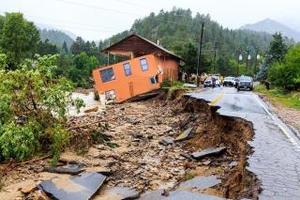InfrastructureColorado faces costly, lengthy challenge fixing flood-damaged roads
The Colorado Department of Transportation(CDOT) has met the 1 December 2013 deadline to reopen twenty-seven flood-battered highways in the state, but the department still faces major challenges in making permanent fixes to damage caused by September’s historic floods. The scope of the task is currently being evaluated as highway managers explore technological and engineering changes needed to keep about 485 miles of damaged roadway more resistant to mass flooding.

Colorado floods wreaked havoc on the roads // Source: hhs.gov
The Colorado Department of Transportation (CDOT) has met the 1 December 2013 deadline to reopen twenty-seven flood-battered highways in the state, but the department still faces major challenges in making permanent fixes to damage caused by September’s historic floods. The scope of the task is currently being evaluated as highway managers explore technological and engineering changes needed to keep about 485 miles of damaged roadway more resistant to mass flooding.
TheDenver Post reports that it may take the CDOT forty-eight months to complete the permanent fixes needed on flooded roads. Johnny Olson, CDOT’s incident commander for the state’s infrastructure recovery, said, “We were charged with getting residents reconnected with their communities by getting these roadways done, and done to ensure safety by Dec. 1, and we did that,” said Olson. “Now we have to go back and evaluate and make repairs based on the long term.” By 31 December 2013, CDOT expects to have an accurate calculation of the repairs needed to make the roadways sustainable for the long term. By Spring 2014, the department plans to begin work on permanent “early out” projects that require minor repairs.
Colorado’s major highways, including U.S. 34 in Big Thompson Canyon, will require a much longer time to evaluate for repairs, and such repairs are likely to be more detailed and challenging. Sections of U.S. 34 are receiving particular attention because it was once destroyed by the 1976 Big Thompson Flood and later rebuilt to withstand future major floods.
“It was built to be indestructible,” said Governor John Hickenlooper. “You see that it is very hard to be indestructible.”
According to CDOT executive director, Don Hunt, engineers are considering two options for the permanent rebuilding of U.S. 34 — reconstruct a road which will resist nearly any kind of flooding, or build a less expensive but more vulnerable highway. The department plans to reach a conclusion on which option to proceed with during the next few months. According to Olson, questions to consider include: “What can we do to prevent this curve from washing out? What kind of striping does this stretch need? And what can we put under the surface of the roadway to make it last?”
Olson warned that residents should not expect complete makeovers to damaged roads. Funding for repairs, including $450 million in state and federal funds, must be spent on specific damages. One-third of the $450 million has been allocated toward temporary fixes, and the remainder will go toward permanent reconstruction. CDOT is unsure whether more federal funding will be available to the department in the near future. “Wherever there is damage, we can look at improving standards to protect us in the future,” Olson said. “But we can’t go through the whole U.S. 34 corridor and make changes.”
County roads in Colorado also face months and possibly years of repairs due to September flooding. “Hopefully, in some areas, we will be able to do permanent construction this summer,” said George Gerstle, transportation director of Boulder County, where the flood destroyed roads leading into mountain communities. “Others may take another year for design and construction because of the magnitude of the damage.”
The Post notes that Boulder County road crews have already rebuilt about thirty miles of canyon roads within two months to make them driveable, yet many county roads and bridges still suffer damages from creeks leaving their banks and forming new channels. As road crews make temporary fixes, Boulder County is exploring designs that will make bridges and roads more resistant to major floods that are likely to strike again. “We are doing significant analysis on how we can construct roads and bridges that can withstand major flooding, which will come sometime in the future,” Gerstle said.
